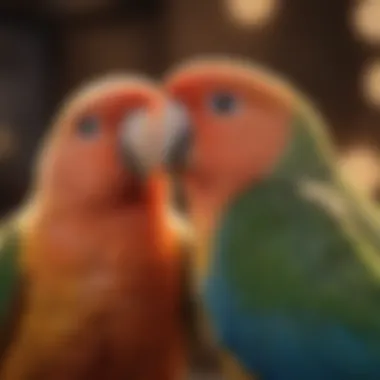Understanding Lovebirds: Care and Connection


Intro
When it comes to pets, not all little companions are created equal. Lovebirds, with their vibrant colors and lively personalities, often steal the show in the avian community. These small parrots pack a significant punch when it comes to companionship, offering a level of affection that can rival larger birds. If you're ready to dive into the world of lovebirds, you're in for a delightful journey. We'll explore everything from their basic care to the emotional connections they establish with us. Understanding these charming birds is the first step toward nurturing a happy, vibrant home together.
Avian Care Basics
Taking on the responsibility of a lovebird requires a solid foundation of avian care essentials. Proper nutrition, habitat setup, and hygiene practices are crucial components that can’t be overlooked.
Importance of Proper Nutrition
Just like humans, lovebirds need a well-rounded diet to thrive. A mix of high-quality pellets, vegetables, seeds, and some fruits creates a nutritious balance. It's not just about filling their bellies; a proper diet boosts their energy levels and contributes to vibrant plumage.
- Pellets: The cornerstone of a lovebird's diet.
- Fresh Vegetables: Think leafy greens and veggies like carrots.
- Fruits: Treats like apples or berries can be a real hit!
- Seeds: Offer them, but in moderation to prevent obesity.
Feeding time can also serve as an engaging activity, allowing you to bond with your pet as they get to know the flavors of their meals.
Understanding Bird Species and Their Needs
Before bringing a lovebird home, understanding the species’ specific needs is vital. For instance, there are several species of lovebirds, each with unique traits. The Peach-faced lovebird is well-known for its sociable tendencies, while the Fischer's lovebird may be a tad more reserved. Each variety might require different stimuli and interaction levels.
Basics of Birds Habitat Setup
The home you create for your lovebird is its sanctuary. A spacious cage with ample room for them to spread their wings is a must. Inside, consider adding perches of different sizes to encourage exercise, toys to stimulate their minds, and a safe nesting area. Don't forget about natural sun exposure, as sunlight plays a pivotal role in the health of your bird.
Grooming and Hygiene Tips
Keeping your lovebird clean and well-groomed is essential. Regular feather baths are important, as they help maintain the quality of their feathers, allowing them to keep those colors bright. Also, trim their nails periodically to prevent discomfort. Cleaning the cage regularly is a non-negotiable aspect of lovebird care – a clean environment fosters a happier and healthier bird.
Interacting with Your Pet Bird
Once you've set everything in place, interaction with your lovebird becomes the heart of your bond.
Building Trust and Connection
Establishing trust is key. Start with short interactions, allowing your lovebird to get comfortable with your presence. Speak softly and offer treats when they show curiosity towards you. Over time, you’ll see them come closer and begin to feel secure in their environment.
Training Techniques and Tips
Training lovebirds can be an enriching experience for both of you. Simple commands like "step up" or teaching them fun tricks can stimulate their minds. Using positive reinforcement, like delightful treats, encourages them to learn.
Fun Activities for Bird Owners and Their Birds
Incorporating playful activities enriches the lovebird experience. Consider games such as hide and seek with toys or setting up obstacle courses. Lovebirds are inquisitive by nature, so engaging them can lead to deepened relationships.
Recognizing Bird Cues and Behaviors
Understanding your bird's body language is crucial. Are they puffing up their feathers? This may indicate they need some alone time. Knowing these cues allows for better interactions, ensuring a happy pet.
Emotional Well-Being of Birds
The emotional landscape for lovebirds is vast. They thrive on companionship and stimulation, making emotional well-being a priority.
The Role of Play and Socialization
Lovebirds are social creatures by nature. Regular interaction, playtime, and opportunities to socialize with other birds are central to their happiness. Forcing them into isolation can lead to behavioral issues.
Enhancing Birds' Emotional Health
Creating a stimulating environment helps enhance your lovebird's emotional health. Rotate toys, introduce new activities, and even consider bird-friendly music or sounds to keep their spirits up.
Assessing Bird Stress and Remedies
Observed any sudden changes in behavior? That could be a sign of stress. Look for signs like excessive screeching or feather plucking. Providing a calm, safe space and spending quality time can help ease their anxiety.
Building Strong Human-Bird Bonds
Investing time and effort into understanding your pet pays dividends. Regularly spending time in meaningful interactions forms a bond that often rivals traditional pet dynamics.
Bird Health and Safety
Just like any other pet, maintaining a healthy environment is crucial.
Common Health Issues and Prevention
Awareness of potential health issues can prevent future complications. Issues like respiratory problems or feather plucking can arise due to stress or poor living conditions. Regular check-ups can minimize these risks.
Routine Veterinary Care
Finding an avian vet is paramount. Regular check-ups keep tabs on your lovebird’s health, ensuring they're thriving.
Environmental Hazards to Avoid
Birds are curious creatures. So, everyday items can become hazards. Ensure there's no access to toxic plants, open flame, or harmful cleaning agents.
Signs of Illness or Distress


If your lovebird appears lethargic, changes in appetite or behavior, or shows unusual feathers, consult a vet immediately. Early detection can be a lifesaver.
Fun Facts and Quirky Insights
Exploring the lighter side of lovebirds can be enjoyable.
Unique Traits of Popular Bird Species
Lovebirds are known for their affectionate nature. Some species even form extremely strong pair bonds, making them valuable companions.
Historical and Cultural Significance of Birds
Birds have been symbols in various cultures. In ancient Egypt, for instance, they were revered and depicted in art, showcasing the longstanding human fascination with avians.
Famous Bird Owners and Their Stories
Many notable figures have had lovebirds as pets. From musicians to artists, these charming little companions have made their mark.
"A bird does not sing because it has an answer. It sings because it has a song." - Chinese Proverb
Lovebirds offer a unique insight into the world of pet ownership. Understanding their needs, behaviors, and health can transform your relationship into a fulfilling journey. With the right knowledge and care, you can ensure a long-lasting bond with your feathery friends.
Prelude to Lovebirds
Lovebirds hold a special place in the hearts of pet bird enthusiasts. Their vibrant plumage and affectionate nature makes them a sought-after companion in aviculture. Understanding lovebirds, however, goes beyond their captivating appearance; it encompasses their behavior, care requirements, and the emotional connection they can form with their human caregivers. This introductory section aims to outline the significance of lovebirds as pets, highlighting considerations that potential owners must keep in mind.
Their appeal lies not just in their beauty but in their social demeanor and playful antics. Owners often find themselves captivated by their endearing personalities and complex social structures. By taking the time to learn about lovebirds, one can establish a more meaningful relationship with these creatures; knowledge empowers owners to meet the birds’ needs effectively.
Classification and Species Overview
When we discuss lovebirds, it’s essential to recognize that they belong to the genus Agapornis, which includes several species that vary in colors, sizes, and temperaments. The most common types encountered by pet owners are the Peach-Faced Lovebird, Fischer's Lovebird, and the Masked Lovebird.
- Peach-Faced Lovebird: Known for its stunning colors, the Peach-Faced is a popular choice among bird keepers. Its playful and vocal nature endears it even more to owners.
- Fischer's Lovebird: With green plumage and a charming demeanor, Fischer's is known for its sociability and curiosity. They thrive with companionship and engage well with their environment.
- Masked Lovebird: Easily recognized by its distinct mask, this species displays unique behavioral traits and adaptability to various living conditions.
These classifications reflect diverse breeding and care needs, presenting unique challenges for prospective owners.
Origin and Natural Habitat
Lovebirds are native to Africa, particularly in the sub-Saharan regions. They generally favor wooded areas and bushy savannas, relying on natural surroundings for safety and food sources. This background informs their behavior and social structures; in the wild, lovebirds typically live in small flocks, which reinforce their need for companionship.
In their natural habitat, they exhibit foraging behavior, relying on seeds, fruits, and occasional insects. Observing such habits informs owners about potential dietary needs, illustrating how vital it is to replicate a similar environment at home.
Understanding the origin and habitat further underscores the importance of providing an enriching environment for the lovebird, which can stimulate their innate behaviors. As such, recognizing their background lays the foundation for responsible pet ownership, ensuring that care practices align with their natural tendencies.
By understanding lovebirds' social behaviors and dietary needs, owners can provide better environments that mirror their natural habitats.
Physical Characteristics of Lovebirds
Understanding the physical characteristics of lovebirds is quintessential for anyone either contemplating becoming a pet owner or already immersed in the joyful chaos that lovebirds bring. These colorful little gems not only inject vibrancy into their surroundings but, their unique traits and charm also play a pivotal role in their care and handling.
Size and Plumage Variations
When it comes to size, lovebirds aren't built like your grandpa's bulldog; they're petite, typically ranging from about 5 to 7 inches in length. Despite their small stature, the personality packed into these feathery beings is anything but tiny. The most common breed, the Peach-faced lovebird, showcases a lush green body adorned with hints of peach on the face.
Other species, like the Fischer's lovebird, splash their feathers with striking shades of yellow and blue.
The variations in plumage can be downright astonishing:
- Peach-Faced Lovebird: Bright green with peachy foreheads.
- Fischer's Lovebird: Wrapping themselves in powdery blue alongside pops of yellow and green.
- Masked Lovebird: Sporting a bold mask of colors, resembling a flamboyant little bandit.
These differences aren't just for show; they often reflect health, genetics, and even mood. The brighter the bird, the better their health generally indicates. Ultimately, understanding these nuances can help you spot potential issues before they escalate.
Distinctive Features
Now let’s chat about what really sets these critters apart. Lovebirds come with a fascinating array of distinctive features that not only enrich their aesthetic appeal but also cater to their playful natures.
- Beak: Lovebirds sport strong, hooked beaks. This is a perfect tool for cracking seeds but also serves them well in their playful antics, tearing up toys or, as some owners have discovered, a favorite piece of furniture.
- Eyes: Have you noticed their eyes? These round, bright eyes can be mesmerizing. They seem to express a variety of emotions, from curiosity to mischief, giving you insight into what’s brewing in that little brain.
- Wings and Tail: With sharp, pointed wings and characteristic tail feathers, lovebirds can zip around like tiny rocketships. This is essential when they engage in flying and energetic play, it’s a sight to behold! It's crucial to provide ample space for such activities as their love for movement is deeply rooted in their nature.
Keeping the physical characteristics of lovebirds in mind can greatly influence how you care for them. Their small size and playful stature demand awareness about their behaviors and the environment in which you place them. This attention helps nurture happy and healthy lovebirds while fortifying the bond you share.
"The more we know about the physical traits of our pets, the better we can accommodate their needs and enrich their lives."
In summary, the charm of lovebirds is clearly tied to their unique physical characteristics. By familiarizing oneself with their size, color variations, and distinctive features, future and current owners can ensure a colorful, healthy life for these delightful companions. Established knowledge leads to informed decisions when adopting or caring for your little feathered friends.
Behavioral Traits of Lovebirds
Understanding the behavioral traits of lovebirds is essential for anyone considering these pets. Their quirky and sometimes bewildering behaviors not only shape their interactions with their owners but also affect their health and happiness. Lovebirds are known for their lively and affectionate nature, making it crucial to comprehend their social and vocal behaviors. This section will clarify why grasping these traits can significantly enhance both the owner’s experience and the bird’s quality of life.
Social Behavior and Interaction
Lovebirds exhibit a rich social structure that stems from their need for companionship and bonding. These birds thrive on interaction and often form strong attachments with their owners and, ideally, with each other. They are known to engage in a variety of behaviors to maintain a healthy social environment, such as preening each other, which not only strengthens relationships but also fosters feelings of security.
Key aspects of social behavior include:
- Affectionate Displays: Lovebirds will often nuzzle or cuddle, a sign of trust and bonding.
- Playful Interactions: They enjoy games and activities, which can include swinging on toys or climbing around.
- Mimicking Behavior: Lovebirds are smart and might imitate the activities or sounds made by their human companions, reflecting their keen observational skills.


To ensure that they stay emotionally fulfilled, lovebirds should have regular opportunities for socialization. If you are keeping a single lovebird, dedicating quality time for interaction is imperative. A lonely lovebird can develop stress-related behaviors, such as excessive vocalization or feather plucking.
Vocalizations and Communication
Another fascinating trait of lovebirds is their vocal communication. These birds have a diverse range of sounds they use to convey different feelings and messages. Their vocalizations can range from soft chirps to loud squawks, providing insights into their moods and needs.
Common vocalizations include:
- Chirping: Typically indicates contentment or playfulness.
- Squawking: Often a sign of excitement or distress.
- Whistling: Lovebirds may mimic tunes they hear regularly or create their own melodies.
Vocal communication is not just about sound; it plays an essential role in bonding. Owners who frequently talk to their lovebirds not only stimulate their vocal abilities but also foster a deeper connection. Engaging in conversations with them can lead to an incredible interactive experience that will enhance your relationship.
Common Behavioral Issues
Like all pets, lovebirds can encounter various behavioral issues that may stem from environmental stressors, inadequate social interaction, or owners not understanding their needs. Recognizing these signs early can make a world of difference.
Frequent behavioral issues include:
- Aggression: Lovebirds can become territorial, especially when they feel threatened or possessive of their space or a partner.
- Destructive Behavior: Chewing up furniture or toys may happen if they are bored or lack stimulation.
- Loud Vocalizations: If bored or lacking attention, these birds might vocalize loudly, which can be troubling for neighbors.
Owners should remain vigilant for any changes in their lovebird’s behavior. Establishing a consistent routine and providing plenty of mental and physical stimulation can usually prevent many common issues.
"Understanding lovebird behavior goes beyond mere observation. It is about building a bond through communication and interaction, enhancing the quality of life for both pet and owner."
By delving into the behavioral traits of lovebirds, prospective and current owners can ensure that their feathered companions lead enriched lives filled with companionship and joy.
Nurturing Lovebirds at Home
Caring for lovebirds goes beyond merely providing food and shelter; it encompasses the creation of a nurturing environment that fosters their mental, physical, and emotional well-being. Lovebirds are inherently social creatures, which brings forth the essential need for their habitats to mimic their natural environments to some degree. Thus, understanding the dynamics of a flourishing home for these birds is vital for every owner aiming to cultivate a strong bond and enhance their overall quality of life.
Creating an Enriching Environment
Space Requirements
One of the most critical components of nurturing lovebirds at home is addressing their space requirements. Lovebirds thrive in environments that allow them to move freely and explore. A spacious cage, ideally measuring at least 24 inches wide and 24 inches deep, can offer them ample room to stretch their wings.
Having a cage size that accommodates their playful nature isn't merely a luxury; it forms the backbone of their daily activities, providing room for both exercise and rest.
- Key characteristic: A larger living space minimizes stress and promotes healthier behaviors.
- Unique feature: Spacious environments can prevent behavioral issues that arise from confinement, such as feather plucking.
In summary, ensuring that lovebirds have a generous space is pivotal to maintain their happiness and well-being.
Substrate and Perches
When discussing substrate and perches, it’s crucial to recognize their impact on a lovebird's comfort and health. Using safe substrates, such as paper or aspen shavings, provides a clean area for them to move about. Perches made from natural wood offer them a place to rest and exercise their feet.
- Key characteristic: Natural wood perches come in varying diameters, catering to their needs for grip and foot health.
- Unique feature: Variously sized perches prevent foot problems like bumblefoot, ensuring long-term comfort.
Offering a mix of substrates and perches can transform their living space into a stimulating environment that feels both safe and inviting.
Toys and Activities
Toys and activities play a monumental role in a lovebird's life. Engaging toys, such as chewable wood blocks, foraging puzzles, or swings not only alleviate boredom but also encourage mental stimulation and physical activity. The variety is a key factor here; rotating toys regularly is an effective strategy to keep your birds interested.
- Key characteristic: Interactive toys foster exploration and improve cognitive skills.
- Unique feature: Toys that involve foraging mimic natural behaviors, making them a beneficial addition to every lovebird's habitat.
Dietary Needs and Nutrition
Proper nutrition is the bedrock of a lovebird's health, and understanding their dietary needs and nutrition is fundamental for any owner. A balanced diet ensures vibrant plumage, robust immune systems, and joyful demeanors.
Essential Food Groups
When addressing essential food groups, it's essential to include fresh fruits, vegetables, seeds, and high-quality pellets in their diet. This array of food helps satisfy their varied palate and ensures they receive necessary nutrients.
- Key characteristic: Fresh produce, like leafy greens and berries, provide antioxidants and vitamins.
- Unique feature: A balanced diet stemming from diverse sources can prevent nutritional deficiencies that may lead to health challenges down the line.
Tailoring their diet to include these essential food groups equips lovebirds with the vitality they need to flourish.
Common Dietary Mistakes
However, it’s easy to veer off course, which brings us to common dietary mistakes. Many owners fall into the trap of relying solely on seed mixes. While seeds are appealing, an all-seed diet can lead to obesity and malnutrition.
- Key characteristic: Owners might unknowingly create imbalances in diet, resulting in serious health concerns.
- Unique feature: Establishing a diet rich in variety prevents the pitfalls associated with common dietary missteps.
Being aware of these common mistakes enables owners to foster healthier eating habits in lovebirds.
"The path to a happy lovebird begins with a well-cared-for home and a balanced diet."
In summary, nurturing lovebirds at home isn't just a matter of providing physical space but also encompasses the nuances of a stimulating environment and a balanced diet. Each element interlinks, describing a broader picture where lovebirds can thrive, express their lively natures, and create lasting connections with their owners.
Health Considerations for Lovebirds
Caring for lovebirds goes beyond just feeding and providing a cozy cage; it involves understanding their health needs. This section highlights the importance of health considerations, including recognizing illnesses and employing preventive measures. Owners can help their lovebirds thrive by monitoring their well-being effectively. A healthy bird is not only more cheerful but also fosters a stronger bond with its owner.
Common Ailments and Symptoms


Lovebirds, like all pets, can fall ill. It's important to be attentive to their behavior and physical condition. Common ailments can range from simple allergies to more serious infectious diseases. Here are some typical conditions lovebird owners should be aware of:
- Respiratory Issues: Symptoms might include wheezing or a runny nose.
- Feather Plucking: This habit could suggest boredom or stress.
- Vomiting: Indicates digestive issues that may necessitate veterinary attention.
- Diarrhea: Changes in droppings can arise from dietary inconsistencies or illness.
Watching for these signs is critical. Early detection can make a significant difference in treatment outcomes. Sending a feathered friend to the vet may seem daunting, but it’s vital for their health.
Preventive Health Measures
Taking steps to prevent health issues is key to ensuring your lovebirds live long, happy lives. Here are several preventive measures to incorporate into their care routine:
- Regular Vet Check-Ups: It’s smart to schedule visits at least once a year. Your vet can spot issues before they escalate.
- Balanced Diet: Offering a variety of pellets, fresh fruits, and vegetables is crucial. Avoiding human food ensures they receive the right nutrients.
- Clean Environment: Keeping the cage clean prevents the spread of bacteria and parasites.
- Social Interaction: Lovebirds are social creatures and can become stressed without interactions. Engaging with them regularly reduces behavioral issues.
By prioritizing these measures, you'll provide a solid foundation for your lovebirds' health.
When to Seek Veterinary Care
Even with the best care, illnesses can sometimes occur. It’s important to know when to make that trip to the vet. Some situations that warrant immediate attention include:
- Significant Behavioral Changes: If your bird is unusually quiet or lethargic, it’s a red flag.
- Difficulty Breathing: Struggling to breathe can be serious and needs urgent care.
- Sudden Weight Loss or Gain: Literally keeping an eye on their weight can provide insights into their health status.
If you see any of these symptoms, don’t hesitate.
A stitch in time saves nine. Taking quick action can save a lot of trouble down the road. Your lovebird relies on you to be an attentive caregiver.
Bonding with Your Lovebird
Building a relationship with a lovebird is essential for both the bird's well-being and the owner's satisfaction. Lovebirds are known for their affectionate nature, but this affectionate behavior doesn’t appear out of thin air. Like any relationship, it requires investment of time and effort to cultivate the bond. A solid connection not only enriches the life of the bird but also allows the owner to enjoy the joys of companionship that come with such a unique pet.
Establishing Trust and Affection
Establishing trust with your lovebird serves as the bedrock for all interactions. Initially, it’s crucial to create a calm and quiet environment. For instance, placing the cage in a room that’s not too bustling helps mitigate stress. When you’re near the bird, speak in soft tones and approach gradually. Rushing in can scare them off, acting like a bull in a china shop.
Creating predictable routines is also key. Feed them at the same time every day, and gradually start to interact more. Offering treats when they come close can foster positive associations. Even something as simple as millet spray can work wonders. As they begin to recognize you as a source of comfort and food, they will gradually warm up, leading to greater trust.
Training Techniques and Enrichment Activities
Training your lovebird is more than just teaching tricks; it’s a way to further solidify that bond. Start with basic commands like "step up" or "come here" using treats as motivation. Consistency is vital here; try to practice for short but regular sessions. Remember that patience is a virtue. Lovebirds have short attention spans, and it might take a few tries before they catch on.
Additionally, offering enrichment activities can help in bonding. Simple toys can encourage not only play but also cognitive stimulation. Consider puzzle toys, foot toys, or even swings that they can play with. Unpredictable changes in their environment also pique their curiosity. Rotate toys every so often or even allow them some time outside their cage in a safe area to explore.
The Role of Social Interaction
Lovebirds are inherently social creatures, which makes social interaction a vital element in forging a lasting bond. They thrive on company, whether it’s human or avian. If you’re the only one at home, your lovebird may need extra time out of its cage with you. Spend quality time interacting with them; talking softly, whistling, or even a bit of gentle playing fosters a deeper connection.
If you can, consider allowing your lovebird to spend time with other birds. The social dynamics are intricate; sometimes seeing another lovebird can spark their interest and joy. Just remember to introduce them gradually and monitor their interactions for any signs of aggression.
"A lovebird, when nurtured in a safe environment with interaction, can develop a bond as strong as any furry companion."
Challenges of Keeping Lovebirds
Keeping lovebirds can be one of the most rewarding experiences for pet owners, yet it comes with its own set of challenges that cannot be overlooked. Understanding these challenges is essential for ensuring the health and happiness of your feathered friends. As lovebirds require specific care routines, establishing a solid foundation on these topics offers insights for new and seasoned bird enthusiasts alike.
Marital Dynamics: Single Versus Paired Lovebirds
One of the first hurdles many face is deciding on the living situation for their lovebirds. Should you have a pair, or is it better to keep just one? The idea of keeping a single lovebird might sound easier, especially for first-time owners. However, lovebirds are inherently social creatures, and they thrive on companionship. A single lovebird, without a mate, can easily become lonely or develop behavioral issues stemming from boredom.
When considering a pair, one must also account for the dynamics involved. Lovebirds can form deep attachments with their partners, leading to a range of possible outcomes:
- Positive interactions: Paired lovebirds often engage in mutual grooming and play, creating a lively environment that enriches their quality of life.
- Jealousy and aggression: On the flip side, if not properly socialized, paired lovebirds can develop jealousy. This can be particularly concerning if one is not as dominant, leading to possible fighting.
In summary, the decision between single or paired lovebirds hinges on understanding their social needs and the dynamics that arise from these choices. Choosing wisely helps to ensure that your lovebird is mentally stimulated and emotionally fulfilled.
Behavioral Management Strategies
Every pet has its own quirks, and lovebirds are no different. As endearing as these birds can be, they also exhibit behavioral issues if not managed properly. Implementing specific strategies can create a more harmonious living setting.
- Routine Establishment: Lovebirds thrive on routine. Setting consistent feeding and playtimes helps them feel secure and reduces anxiety.
- Positive Reinforcement: Reward desired behaviors with treats or praise. This reinforces a good habit and strengthens the bond between you and your lovebird.
- Environmental Enrichment: Boredom can lead to issues like excessive screaming or feather plucking. Provide a variety of toys and activities that challenge their minds and encourage their natural instincts.
- Social Interactions: If your lovebird tends to be more aggressive, consider spending time with it outside of the cage. This helps build trust and can mitigate territorial behaviors.
- Correcting Undesirable Behaviors: If unwanted behaviors arise, do not resort to negative reinforcement. Instead, understand the root cause—be it fear, boredom, or insecurity—and redirect their behavior positively.
"Managing lovebirds effectively enhances their well-being, creating a healthier and more balanced environment for both the pet and owner."
Closure
The conclusion of this article serves as a vital synthesis of the core themes surrounding lovebirds as pets. It encapsulates the essential points discussed throughout the guide, ensuring readers grasp their unique needs and the emotional connections they offer.
- By acknowledging the importance of meticulous care, social interaction, and understanding their behaviors, prospective lovebird owners can foster a healthier environment for their feathered friends.
- The bond shared between humans and lovebirds can be profound. As engaged pet parents, individuals must appreciate what it truly takes to nurture these affectionate creatures.
- Furthermore, recognizing common challenges and proactive maintenance of their health can lead to a fulfilling pet-parent experience that transcends mere ownership.
This wrap-up cements the notion that lovebirds are not just pets but companions that bring joy and enrichment to our lives, provided we invest the required time and effort.
Recap of Key Points
As we reflect on the journey through this article, several key points stand out:
- Physical Characteristics: Lovebirds, while small, possess vibrant plumage and distinctive features that elevate their playful nature.
- Behavioral Traits: Their social behavior and communication are critical elements that influence how they interact with their environment and caregivers.
- Health Considerations: Routine health checks and a good diet lay the groundwork for their long-term health and happiness.
- Bonding Techniques: Establishing trust through consistent interaction is paramount in creating a lasting relationship with a lovebird.
- Challenges of Ownership: Understanding the dynamics between single and paired lovebirds aids owners in making informed decisions about companionship.
This summary enables readers to grasp a netter understanding of the responsibilities involved in lovebird care.
Future Considerations for Prospective Owners
For those contemplating bringing a lovebird into their home, several crucial considerations can shape a fulfilling pet experience:
- Understanding Commitment: Prospective owners must evaluate their ability to spend time with these social birds. Lovebirds thrive on companionship and engagement.
- Researching Best Practices: Familiarizing oneself with their diets, habitat needs, and recommended toys before purchase can lead to more informed decisions during the initial setup.
- Considering Adoption: Embracing the option to adopt can not only provide a loving home for a bird in need but also enrich the owner’s life with a unique story.
- Engaging with Communities: Joining forums or local bird clubs allows new owners to glean insights from seasoned bird parents, ensuring a supportive environment full of shared experiences.
By weighing these considerations, future lovebird owners can embark on their journey well-prepared. With the right mindset and resources, they can foster a rich relationship that enhances both their lives and those of their charming companions.















